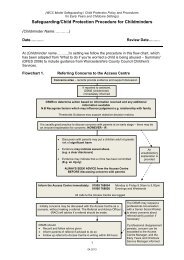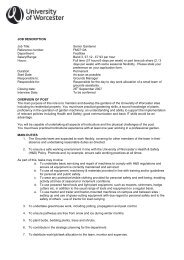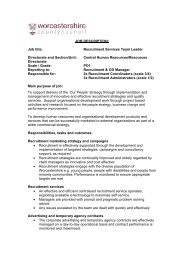Planning for Renewable Energy in Worcestershire Research Paper
Planning for Renewable Energy in Worcestershire Research Paper
Planning for Renewable Energy in Worcestershire Research Paper
Create successful ePaper yourself
Turn your PDF publications into a flip-book with our unique Google optimized e-Paper software.
Appendix C. Example calculations of Annual<strong>Renewable</strong> Electricity generated by differenttechnologiesFor the purposes of provid<strong>in</strong>g an estimateof how the renewable energy targetsmight be achieved, the follow<strong>in</strong>gassumptions and calculations have beenused.To calculate the annual electricitygeneration, <strong>in</strong> GWh, <strong>for</strong> each technology,the <strong>in</strong>stalled capacity is multiplied by thenumber of hours <strong>in</strong> a year, and multipliedaga<strong>in</strong> by the 'capacity factor'. Thecapacity factor takes account of real-worldscenarios, by ensur<strong>in</strong>g that calculations<strong>in</strong>clude the sub-optimal average operationCalculation:Installed Capacity<strong>in</strong> GW(to convert from KW to GW,multiply by 0.000001to convert from MW to GW,multyply by 0.0001)=XNumber of hoursper year24 x 365= 8760Electricity generated per yearof the apparatus (e.g. w<strong>in</strong>d turb<strong>in</strong>es willnot always be operat<strong>in</strong>g at full capacitydue to w<strong>in</strong>d speeds be<strong>in</strong>g too weak or toostrong). With the exception of w<strong>in</strong>dturb<strong>in</strong>es, the capacity factors <strong>for</strong> eachtechnology have been taken from SouthEast <strong>Energy</strong> Statistics, which is led by theGovernment Office <strong>for</strong> the South East andfunded through the South East EnglandDevelopment Agency and the South EastEngland Regional Assembly. The capacityfactor <strong>for</strong> w<strong>in</strong>d turb<strong>in</strong>es has been takenfrom the Companion Guide to PPS22.XCapacity Factorof Appliancee.g. 30% or 0.3APPENDIX C ● <strong>Plann<strong>in</strong>g</strong> <strong>for</strong> <strong>Renewable</strong> <strong>Energy</strong> <strong>in</strong> <strong>Worcestershire</strong>Solar PV:The figure <strong>for</strong> solar photovoltaics (PV) isbased upon a case-study example with<strong>in</strong>the Companion Guide to PPS22, whichillustrates a school build<strong>in</strong>g fitted with10kW of photovoltaic tiles, which equatesto 0.00001GW. It is considered that suchan <strong>in</strong>stallation would be viable on manylarger-scale public and private sectorbuild<strong>in</strong>gs throughout the County. Thecapacity factor <strong>for</strong> solar PV has beencalculated as 0.07.Each solar array of this scale wouldproduce0.00001 X 8760 X 0.07 =0.006132 GWh/year.To supply the entire renewable electricitytarget <strong>for</strong> the County, the number of solarPV arrays of this scale required would be155 / 0.006132 =25,277.234 ~ 25,300 solar PV arraysTechnical <strong>Research</strong> <strong>Paper</strong> 51
















